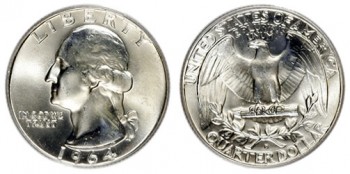Silver Washington Quarters were first released by the United States Mint in 1932 as part of a bicentennial celebration of the birth of the first President of the United States, George Washington. The silver versions of the quarter would be discontinued after 1964 as coinage shifted to a clad composition. However, the use of the obverse portrait of Washington continues to this day.
These Washington Quarters have a total weight of 6.25 grams and a composition of 90% silver which amounts to 0.1808 ounces of the precious metal in each coin (melt value information on the quarter may be found by using the calculator in the right column).
The obverse of the coin showcases a portrait of George Washington with the reverse depicting a perched eagle with outstretched wings. Both were designed by sculptor John Flanagan. Prior to the release of coins, the U.S. Mint had been striking the Standing Liberty Quarter since 1916.
Historical Washington Quarter Silver Coin Melt Values
Congress was looking for ways to commemorate the bicentennial of the birth of George Washington and had originally focused on the half dollar. Plans were to issue a special commemorative 50c piece for one year that depicted Washington. Those plans were set aside when new legislation was introduced that directed Washington’s image to be used on quarters. Not only did his image appear on the 1932 coin as a small commemorative to the first President, but it would also be used in the following years as it permanently replaced the Standing Liberty design which had been problematic for the U.S. Mint since its debut.
For the coin’s creation, artists were invited to submit design proposals. Despite objections from the United States Commission of Fine Arts (CFA), the work of sculptor John Flanagan was chosen by the Secretary of the Treasury. The coin would feature an obverse portrait of Washington based on a bust of the President by French sculptor Jean-Antoine Houdon, as required by the original authorizing legislation. Obverse inscriptions include “LIBERTY,” “IN GOD WE TRUST” and the year of minting.
The reverse showcased an eagle perched on a bundle of arrows with outstretched wings and an olive branch shown underneath. Reverse inscriptions include “UNITED STATES OF AMERICA,” “E PLURIBUS UNUM” and “QUARTER DOLLAR.”
Silver Washington Quarters underwent several small modifications over the years but each remained true to the original design. Flanagan’s designs proved to be exceptional for striking as a high level of detail is seen even in worn coins.
In 1965, the U.S. Mint switched to a clad version of the quarter dollar discontinuing its silver composition. However, the use of the Flanagan designs continued.
Washington Quarters can be very collectible. There are two major key strikes of the series, the ‘D’ and the ‘S’ issues from the first year which featured mintages of just over 400,000 each. Mintages in the millions were standard for other issues with some even reaching into hundreds of millions.
Low grade Washington Quarters in silver, termed junk silver coins, are also relatively valuable owing to the 0.1808 ounces of the precious metal which provides for decently high melt values.

